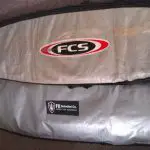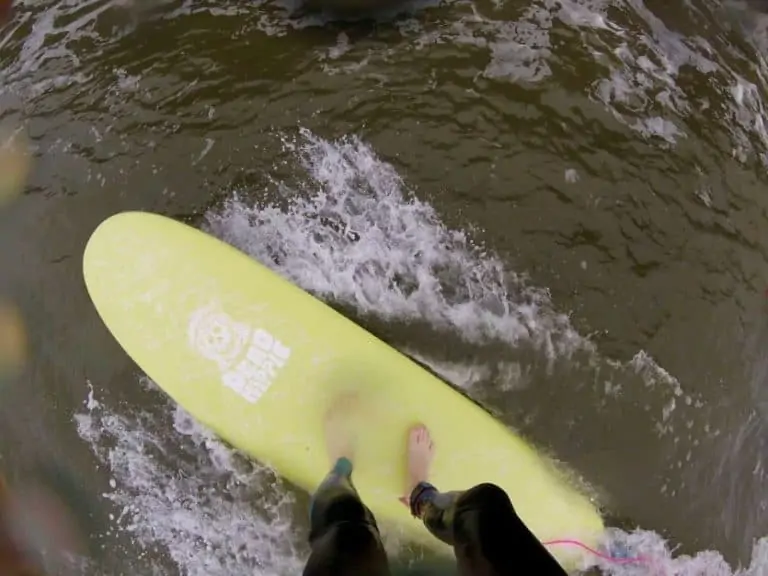How to Take Care of Your Surfboard: The Complete Guide
Surfboards are expensive and fragile, so taking good care of a surfboard is the best way to make your board last as long as possible.
Looking after your board properly can be a little tricky if you have not had one before, so here’s my guide to helping you keep your board in the best condition possible.
Keep your surfboard upright in a bag or protective cover when not in use, stored out of sunlight. Lean it upright against a wall, ideally in a corner with the leash hanging over the fins or loose in the bag. Fix all dings before you surf again and never let anyone stand on it on dry land
Now, those are the main things to do but there’s quite a few more things to be aware of, so let’s have a look at these and all the useful tips below to make sure you take the absolute best care of your surfboard!
How should I store my surfboard?
The best way by far is to put your surfboard in a bag or protective cover when not in use.
Keeping your surfboard in a surfboard bag is a great way to take care of it since these bags have the padding to protect your board from knocks or dings.
There are 3 main types of surfboard bags:
- Day bag
- Travel bag
- Coffin bag
Day Bag
As you might have guessed, a day bag is great for day-to-day use and will be a great option for carrying your board to and from your favorite surf spot.
These day bags are great for cars slinging your board in a car, too, since they are padded but not as heavily as the other two board bags listed above, meaning that they are not as bulky so take up a little less space.
Travel Bag
You will want to get a surfboard travel bag when you are going on longer distance surf trips, usually involving flying.
These have more padding than standard day bags as they are designed to handle the bumps and knocks from being carried on an airplane (and handled by baggage handlers!)
They are also heavier and bulkier given the added protection so they are not the best option day to day but can be good option if you want to save money and get a board bag that will protect your board and can be taken on longer trips.
Coffin Bag
Coffin bags are really getting into the specialist surf category so we won’t spend long on them here. They are called coffin bags because of the depth; these board bags are designed to handle 3-5 boards so they are so deep that they look like a coffin, hence the name.
These are unsurprisingly the most expensive board bags you can buy and are really for those who need to take a full quiver of surfboards with them on their travels.
Coffin board bags are definitely not recommended for anything other than a mega surf trip with the need for lots of boards, which is pretty much just pro surfers or those going on a long adventure.
Alternative Option: Surfboard Cover or ‘Sock’
One last type of protection that you can get for your surfboard is a surfboard cover, or sometimes called a ‘sock’.
These are handy for minor bumps and knocks but do not generally protect your board from dings, more from scratches or things on the surface.
These are usually colorful and made from elasticated fabric, but the name ‘sock’ really is a good description since they don’t provide much more protection than a sock would for your foot out of a shoe!
The appealing thing about getting a surfboard cover or sock is that they are the cheapest option available, but given the limited use and protection, it might be worth just going for a day bag for your surfboard instead.
Store Your Surfboard Upright
For maximum care, make sure you store your surfboard somewhere upright rather than lying on the ground.
This means that nobody will be able to fall on it or drop things on it. Chances are that if you leave your surfboard low down, it could easily get dinged or damaged with people passing by.
It only takes a simple trip or slip to bring an end to your beautiful surfboard as they can, and do, break.
It’s pretty obvious but a flat surfboard on the ground is a terrible idea and can greatly increase the chances of a broken board and an expensive replacement!
Lean it against a wall in a corner to stop it falling over
I see quite a few learner surfers store their surfboard upright against a wall in the middle of a room. Unfortunately, this too is a hazard since most surfboards have a round ‘tail’ on the bottom end near the fins.
To avoid this kind of problem, simply place your surfboard upright in the corner of a room against two walls.
This should mean that your board can’t really slide from side to side. If, like me, you have a low-ceilinged apartment or room, and you’re worried about your surfboard sliding out from the bottom, you can easily put something under it to stop that happening. I say this because I can’t stand my bigger surfboards exactly upright because of how low the ceiling is and how tall the board is!
A simple item like a rug or a hand towel can prevent your board from slipping from its upright position and keep it that bit safer from damage.
Tie your leash so that it won’t get caught
Before leaving your surfboard, you should also tie your leash so that it won’t get caught.
This is an issue since your leash will have a Velcro closure and this can stick to things like clothes, animals and more as they pass by – not good!
No doubt you can image the sight of a passerby accidently getting caught in your precious surfboard leash and inadvertently pulling your board along with them.
To avoid this, wrap your leash around your fins a few times until it is tight and then try to close the leash around both the cord and the nearest fin.
This should keep your leash in place and out of harm’s way, as well as keeping the Velcro on the leash covered.
Get a Surfboard Rack
Another good tip for taking care of your surfboard is to get a surfboard rack.
You can get surfboard racks in the following ways:
- Upright surfboard racks
- Wall-mounted surfboard racks
- Hanging from the ceiling
Upright Surfboard Racks
Upright surfboard racks go along the wall of a room and can easily be installed with minimal equipment. The only issue with them is that they take up quite a lot of floor space, so definitely think about the space needed before buying and installing them (you might not be popular if they take up too much room!)
Wall-mounted Surfboard Racks
You can get these in either angled or flat racks. Angled wall-mounted surfboard racks generally come in sturdy metal and are the kinds of racks you might see surfers use on the outside of the class Volkswagen campervans (but don’t worry, they can be used indoors, too).
The flatter versions are less well-known, mainly because you can make them, as my dad did for me when I was younger!
To make your own wall-mounted surfboard racks, look into getting two strips drilled into the wall, be it metal or from wood, and then get two horizontal bars or poles for each surfboard. These can handle quite a few and can go above doorways and be installed in ‘dead’ spaces that are not currently used.
I’d just say to avoid doing what I instructed my dad to do and install above your bed – you really don’t want that kind of thing coming down on you in the night!
Ceiling Surfboard Racks
You can also get ceiling hanging surfboard racks. These come in a variety of options, with some being metal chains with pads on them.
These are probably the trickiest to install so think carefully before buying any
Never let anyone stand on your surfboard on dry land
I know this sounds obvious but you really don’t want anyone to stand on your surfboard on dry land.
I have seen people playing with surfboards like they are toys, but they are generally quite fragile items when not in the sea.
That means not letting your children play with them, or even your friends or family!
The first problem with this is the fins on the bottom. Surfboard fins are fragile and expensive. If they break, they can also cause the fin ‘box’ that houses them to rip out of the board as well. If that doesn’t happen, they can still rupture through the surface of your surfboard, so standing on a surfboard should be an absolute no-no.
The other issue with standing on a surfboard on dry land is because it means that you can damage the bottom of your board, if you’ve taken the fins out, that is.
It would only take a small stone to crack and ding your surfboard if standing on it on dry land. Again, it doesn’t seem like it would be worth it for many people in that case given the cost and time involved in repairing a board compared to just not standing on it in the first place!
Sometimes I see people trying to pretend to take off on a surfboard on dry land for practice. While this might be OK on some boards on the soft sand, it’s definitely not OK anywhere other than on super soft ground (think the beach or grass).
Instead, it’s easy enough to practice your take off on the floor or a simple yoga mat; doing it on your surfboard won’t really help you other getting a feel for how it is. If you really want to practice your surf take-off, then write down the width of your board and mark your floor or yoga mat with some tape so you know how wide it is.
Is it bad to leave a surfboard in the sun?
Yes, it is bad to leave a surfboard in the sun for long periods. This is even worse if you leave it indoors or in a locked car with shut windows. Surfboards can get damaged if you do this for too long. That said, leaving on the floor outdoors for a short period is fine.
Do not store surfboards in direct sunlight
If you store your surfboard in direct sunlight, it can cause the board to delaminate, turn yellow and, for some of the newer technology boards, even cause pressure issues.
If you have to store your surfboard in direct sunlight, then use a board bag or cover, as mentioned above.
Doing this should mean that you can avoid many of the issues related to direct sunlight since the surfboard will be protected from the direct UV rays.
That said, a surfboard in a board bag can still heat up and cause the wax to melt and run off your board. This is not a pretty sight and is frustrating to clean up so think about that before storing your board!
How do I keep my surfboard from turning yellow?
To keep your board from turning yellow, try the following:
- Avoid storing your board in direct sunlight
- Fix all dings before you surf again
So, as we’ve covered why storing your board in direct sunlight is bad above, I’ll just recap that this will make your board heat up and possibly delaminate. If you can, use a protective board bag or store your surfboard out of the direct sunlight.
Fix all dings before you surf again
If you see a ding or a crack in your surfboard, it’s important to take care with these and get them fixed before you ride your board again.
If you decide to go out in the surf with a surfboard that has a ding in it, then you will get water in your board which can cause it to get waterlogged and even make it feel much heavier.
The other problem with the water getting inside of your board is that it will mean that you need to wait a long time for it to dry out before it can be properly fixed (trust me on this one – been there, done that – not good!).
This can cause a kind of a bruised pattern to appear, with fiberglass/polyurethane surfboards showing a darkened or wet patch where the water has got in.
This in turn can permanently damage or weaken the part of your board that has had the water damage. I know this from experience, too, since I carried on surfing on a broken board and let it get so bad that the nose fell off mid-surf when I fell on it during a wipeout, leaving me with a jagged surfboard and even more of a repair!
Instead, you can avoid all of the hassles that I have had and take better care of your surfboard. If you get your surfboard fixed before you surf again, then you will make the repair process faster and avoid damaging your board ‘internally’ or possibly permanently.
If you are not confident in repairing surfboards, then take it to a local surfboard store. They will be able to give you a rough price before you leave it with them so there shouldn’t be any issue there.
If you really want to fix a broken board, then make sure you buy the right kind of repair kit for your type of surfboard as each one has different chemical properties depending on the type of the board.
For standard surfboards, SolaRez is a standard repair kit fiberglass or polyurethane surfboards (the standard surfboard), while epoxy surfboards have their own epoxy resin and filler. Foamie or ‘soft top’ surfboards generally rely on glue or adhesive but these are perhaps harder to fix for that reason.
If you have any other type of surfboard then check out the materials that it’s made of online and buy the right kind of repair kit for your board.
Leaving Your Surfboard in a Hot Car
In terms of care, leaving your surfboard in a car with closed windows and doors should be avoided wherever possible. This is because your car will heat up quickly and your board will soon follow.
Surfboards are not made to be heated up and can be permanently damaged if left in a hot car like this.
You may also find that your surfboard delaminates if you leave it in a hot car for a long period of time. Delamination is a serious issue for surfboards and can take a lot of time and money to fix, if it can be fixed at all.
Your surfboard wax will also melt if you leave your board in your car. This can happen quite quickly and is a real mess to tidy up. Imagine somebody dripping wax all over your car seats and upholstery – because that’s how your car will look if you leave your waxed surfboard in there while it’s in direct sunlight!
If you have to leave your surfboard in a hot car, then make sure you leave a window open as the air flow will help to keep the temperature down a little, although this won’t do much for direct sunlight.
The other best thing to do for moments when leaving your surfboard in your vehicle is a must is to put your board in a board bag.
I say this because board bags have reflective materials that help to keep them cool. If you don’t have a board bag for your surfboard then make sure to choose one that has this kind of material.
Related Questions
Should you rinse your surfboard?
It’s always a good idea to rinse your surfboard in fresh water after use as salt water from the sea can cause some minor issues over a long time. That said, not rinsing your board is unlikely to be a big deal, even in the long term, so don’t worry too much if you don’t do this often.
How long should a surfboard last?
If well cared for, a surfboard should last many, many years. Epoxy surfboards last a very long time, as do some of the surfboards with hybrid constructions. A soft ‘foamie’ surfboard should also last many years.
The main differences in how long surfboards last is in their use and care.
If you use a surfboard frequently and in powerful surf, it is pretty obvious that this won’t last as long as a board that is hardly ever used and, when it is, is ridden in small waves with little power.
Why do surfboards break? Surfboards break because they are long and thin, so when a really powerful wave lands on them in the middle, they are not able to withstand the impact. They can also break if fallen on or if made weaker by having dings and being waterlogged.
To avoid breaking your surfboard, fix all dings as quickly as possible and think twice about surfing super powerful, hollow waves if you are really worried.
How long does it take for a surfboard to dry out? Depending on the weather, it can take up to a week for a surfboard to dry out. This is because warmer weather can help it to dry faster. You should also store your board so that the water will drain out of the ding it got in through.
Just make sure you find the main entry point for the water and place your surfboard in the appropriate way to make sure you use gravity to speed up the drying out process.
Are pressure dings on surfboards bad? No, pressure dings are not bad on your surfboard as they are a natural sign of wear and tear and are unavoidable. However, if they get really deep they can lead to cracks so keep an eye on them but don’t let them worry you.
If you want a stronger surfboard, epoxy surfboards generally don’t get many pressure dings but they are also much harder and less forgiving than your standard surfboard, so there is a tradeoff to think about there.
The main problem for pressure dings in surfboards is with boards that have a very light ‘glass job’; this is when a super lightweight layer of fiberglass has been used by the person who made the board to make it lighter. Again, the problem here is that lighter means weaker in a surfboard, so don’t expect a superlight fiberglass/polyurethane surfboard to last very long.
Can you keep surfboards outside? Yes, you can keep surfboards outside but keep them out of direct sunlight if you do. A better option would be to keep your surfboard indoors, but if outside is your only option then try to place them in the shade as the direct sun over a long time can cause problems for your surfboard.





